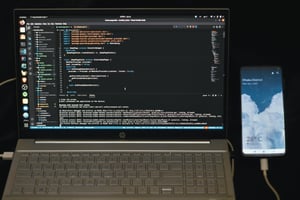Are you curious about optimizing your Node.js logging with Prometheus NodeJS? Consider a Node.js...
A Simple & Quick Introduction To Datadog NodeJS Application Monitoring
Do you need help with NodeJS logging? Monitoring NodeJS applications with Datadog can transform your project. This blog will show you how Datadog NodeJS enhances your monitoring capabilities and keeps your AI voice cloning project on track.
New to NodeJS logging and looking for an effective solution? NodeJS logging with Datadog can optimize your logging procedures. Read the contents below to see how it can benefit you.
Table of Contents
- What Is NodeJS Monitoring?
- Why is Node.js Monitoring Necessary?
- NodeJS Monitoring Tools - How Do They Help in Real-Time Tracking and Analysis?
- Why Is NodeJS Monitoring So Crucial
- What Is Datadog?
- Key Features of Datadog for NodeJS Monitoring
- What Metrics Can You Monitor With Datadog?
- Challenges of Monitoring Datadog NodeJs
- 5 Datadog Alternatives for Monitoring NodeJS
- Catch Issues Before They Affect Your Users With Alerty's NodeJS Logging Tool
What Is NodeJS Monitoring?

Node.js monitoring is a vital strategy to ensure:
- Optimal performance
- Behavior
- Health of Node.js applications
By tracking and analyzing the application's runtime environment, developers can gain valuable insights into various metrics such as:
- CPU usage
- Memory consumption
- Event loop activity
- Request latency
- Error rates
By monitoring these metrics in real-time or over a specific period, developers can:
- Identify performance bottlenecks
- Diagnose issues
- Optimize resource usage
- Ensure the application's overall reliability and scalability.
The process typically involves utilizing specialized tools and software solutions to:
- Capture
- Aggregate
- Visualize performance data
These tools play a crucial role in helping developers and system administrators navigate the complexities of Node.js applications, ensuring the application's smooth operation and seamless user experience.
Why is Node.js Monitoring Necessary?
-1.jpg?width=2400&height=1600&name=jefferson-santos-9SoCnyQmkzI-unsplash%20(1)-1.jpg)
Node.js monitoring is crucial in ensuring the smooth operation and optimal performance of Node.js applications. By tracking and analyzing various metrics and data points, developers can:
- Identify and address performance bottlenecks
- Optimize resource usage
- Diagnose issues
- Enhance the application's reliability and scalability
Monitoring Node.js applications in real-time or over a specific period enables developers to take proactive measures to prevent potential issues and maintain a seamless user experience.
Optimizing Node.js Applications with Monitoring
Through monitoring, developers can gain insights into the internal workings of Node.js applications, enabling them to make informed decisions to enhance:
- Performance
- Reliability
- Scalability
By utilizing specialized tools and software solutions designed for Node.js monitoring, developers can optimize the application's runtime environment, ensuring its smooth operation and seamless user experience.
NodeJS Monitoring Tools - How Do They Help in Real-Time Tracking and Analysis?

Specialized tools and software solutions are vital in tracking and analyzing the following:
- Performance
- Behavior
- Health of Node.js applications
These tools help developers and system administrators gain valuable insights into their internal workings by:
- Capturing
- Aggregating
- Visualizing performance data
NodeJS monitoring tools enable real-time tracking and analysis of metrics such as:
- CPU usage
- Memory consumption
- Event loop activity
- Request latency
- Error rates
By providing a comprehensive view of the application's runtime environment, developers can quickly:
- Identify performance bottlenecks
- Diagnose issues
- Optimize resource usage
- Ensure the application's overall reliability and scalability.
Through specialized tools and software solutions, developers can effectively monitor and manage the performance of Node.js applications, ensuring their smooth operation and optimal performance. These tools offer a user-friendly interface for visualizing performance data, making it easier for developers to track and analyze the application's behavior in real time.
Why Is NodeJS Monitoring So Crucial

As functionalities expand and user bases grow, performance inevitably becomes a concern. Effective monitoring allows you to monitor emerging bottlenecks before they escalate into user-facing problems. This practice helps you identify optimization opportunities within your Node.js application when it's working smoothly.
From Troubleshooting to Optimization
You might be here for two reasons: either wrestling with performance challenges or aiming to enhance your app's performance analysis across various conditions. If you fall into either camp, keep reading to explore effective performance monitoring techniques.
Related Reading
What Is Datadog?

Datadog is a monitoring and analytics tool that provides performance metrics and event monitoring for IT and DevOps teams. It can monitor different services, such as:
- Servers
- Databases
- Tools
The Need for Visibility in Scaling Node.js
As you scale your Node.js applications, you must have complete visibility into their health and performance for effective troubleshooting. Datadog APM offers detailed performance insights and traces requests as they move across distributed services and hosts, helping you identify bottlenecks and debug errors.
Implementing Datadog APM for Node.js
Deploying Datadog APM for Node.js applications involves installing the Datadog Agent and the dd-trace library on your application servers. The dd-trace library automatically instruments requests to commonly used modules in the Node.js ecosystem, such as web frameworks and data stores.
Optimizing Performance with Node.js and Datadog APM
Datadog APM's dd-trace library is compatible with Node.js versions 4.7+, 6.9+, and 8+. However, it performs more efficiently in applications running recent Node.js versions because of performance improvements added in 8.3.0+.
Simplify Monitoring With Alerty's NodeJS Logging Tool
To simplify setup, provide a cost-effective solution, and integrate with tools like Sentry, consider using Alerty's NodeJS logging tool for efficient, affordable monitoring. Alerty monitors NextJS, React, Vue, and Node.js, offering database monitoring, incident management, and Real User Monitoring (RUM) for optimized user experience.
Key Features of Datadog for NodeJS Monitoring

Application Performance Monitoring (APM)
Datadog APM provides detailed insights into the performance of Node.js applications. It automatically instruments requests to popular Node.js frameworks (e.g., Express) and databases (e.g., MongoDB, Redis, MySQL). This allows developers to trace requests as they travel through various services, helping to identify bottlenecks and debug errors effectively.
Real-Time Metrics and Dashboards
Datadog enables the collection of real-time metrics from Node.js applications, which can be visualized through customizable dashboards. Developers can track key performance indicators like:
- Throughput
- Latency
- Error rates
This allows for quick identification of performance issues.
Distributed Tracing
With distributed tracing, Datadog lets users see how requests propagate through microservices. This feature helps pinpoint where delays occur and understand the overall flow of requests, making it easier to diagnose performance problems.
Error Tracking
Datadog provides comprehensive error-tracking capabilities, allowing developers to monitor and analyze errors in real-time. This includes viewing stack traces and understanding the context of errors, which is crucial for rapid troubleshooting.
Watchdog Feature
Datadog's Watchdog feature uses machine learning to automatically detect performance anomalies and alert users to potential issues without requiring manual configuration. This proactive monitoring helps maintain application health by notifying developers of elevated error rates or unusual request patterns.
Integration With Logs
Datadog integrates with log management, allowing users to collect and analyze logs from Node.js applications. This integration provides a unified view of:
- Logs
- Metrics
- Traces
This makes correlating data and diagnosing issues easier.
Custom Metrics and Tags
Developers can define custom metrics specific to their applications and use tagging to organize and filter metrics better. This flexibility helps monitor particular application performance aspects critical to business needs.
Synchronized Dashboards
Datadog allows the creation of synchronized dashboards that track incidents across various metrics. This feature provides a holistic view of application performance and enables teams to respond quickly to issues.
What Metrics Can You Monitor With Datadog?

Request Rate
Measures the number of requests received by the Node.js application over time, providing insights into traffic patterns and load. Tracking request rates helps developers understand application usage and load patterns, allowing for better resource allocation and optimization strategies.
Response Time
Tracks the time taken to process requests, whether the average, median, or percentile response times (e.g., 95th percentile). Monitoring response times allows developers to identify performance bottlenecks and inefficiencies, enabling them to improve the overall user experience and application performance.
Error Rate
It is the percentage of requests that result in errors, such as HTTP 4xx or 5xx status codes. A sudden rise in error rates could indicate issues with the application's code or the underlying infrastructure, prompting developers to promptly investigate and address these critical issues.
Error Types
Developers can diagnose specific issues more effectively by categorizing errors (e.g., client vs. server errors). Understanding the types of errors occurring in the application allows for targeted troubleshooting and resolution, minimizing downtime and user impact.
CPU Usage
Monitors the percentage of CPU resources consumed by the Node.js application. High CPU usage could indicate performance issues or inefficient code, and tracking this metric helps optimize resource consumption and improve the application's overall performance.
Memory Usage
Tracks memory consumption, including heap and RSS. Monitoring memory usage helps identify:
- Memory leaks
- Excessive resource consumption
- Inefficient memory management practices
This enables developers to optimize memory usage and enhance application performance.
Latency Percentiles
Measures the distribution of response times, such as:
- 50th percentiles
- 95th percentiles
- 99th percentiles
Understanding the latency percentiles helps identify outliers and performance variations, allowing developers to provide a consistent and reliable user experience across different usage scenarios.
Transactions Per Second (TPS)
Measures the number of transactions processed by the Node.js application per second. Monitoring TPS is crucial for assessing the application's capacity and performance under various load conditions, enabling developers to scale the application infrastructure as needed.
Business-Specific Metrics
Developers gain valuable insights into the application's performance and user interactions by tracking custom metrics relevant to the application's business operations (e.g., user sign-ups and purchase transactions). Custom metrics help assess the application's alignment with business objectives and identify areas for improvement.
Database Query Performance
If the Node.js application interacts with a database, monitoring query performance, including slow queries and response times, is crucial for ensuring optimal application performance. Monitoring database query performance helps identify and resolve bottlenecks and inefficiencies in data retrieval processes.
Network Latency
Measures the time it takes for requests to travel over the network, impacting the overall application performance and user experience. Monitoring network latency helps identify network-related performance issues and optimize communication between different application infrastructure components.
Related Reading
- Node Js Security
- NodeJS Profiling
- NodeJS Metrics
- Node Js Performance Testing
- NodeJS Server Monitoring
Challenges of Monitoring Datadog NodeJs

Monitoring Node.js applications with Datadog offers many powerful features, but it comes with its challenges. One major consideration is the cost. While highly effective, Datadog can become quite expensive, especially for large-scale deployments with extensive monitoring needs.
The pricing model is typically based on:
- Volume of metrics collected
- Number of hosts
- Additional features like logs and traces
These costs can add up quickly for businesses with many services or high-frequency metrics.
Navigating Datadog Complexity
Another challenge is managing the complexity of the setup and configuration. Datadog’s vast array of features and customizable options can sometimes be overwhelming, requiring careful planning and management to ensure you’re getting the most out of the platform without overcomplicating your monitoring strategy.
Properly configuring dashboards, alerts, and integrations can be time-consuming and requires a good understanding of the tool and your application's needs.
Scaling Challenges With Datadog
Scaling can also be a challenge. As your application grows, so does the volume of data that needs to be monitored and analyzed. While Datadog is built to handle scaling, ensuring that your setup remains efficient and cost-effective can be tricky. Continuous optimization is also needed to avoid unnecessary data collection and manage alert noise.
Data Integration and Correlation Complexity
Data integration and correlation is another area where challenges may arise. While Datadog integrates with a wide range of technologies, making sense of data from multiple sources and correlating it effectively can require significant effort.
Alerty: A Cost-Effective Alternative
Alerty offers an alternative for those seeking a more cost-effective solution.
Robust Monitoring and Alerting
Provides comprehensive monitoring capabilities at a budget-friendly price.
Essential Features
Focuses on delivering core monitoring features without the high costs associated with Datadog.
Cost Management
Ideal for businesses looking to manage costs while maintaining effective Node.js application monitoring.
Selective Integrations
May offer a different range of features or integrations, but remains a solid choice for effective monitoring.
5 Datadog Alternatives for Monitoring NodeJS
.jpg?width=2400&height=1800&name=mimi-thian-ZKBzlifgkgw-unsplash%20(1).jpg)
1. Alerty
Alerty is a cloud monitoring service for developers and early-stage startups, offering:
- Application performance monitoring
- Database monitoring
- Incident management
It supports technologies like NextJS, React, Vue, and Node.js, helping developers identify and fix issues.
- Alerty monitors databases such as Supabase, PostgreSQL, and RDS
- Tracking key metrics like CPU usage and memory consumption
- It features quick incident management and Real User Monitoring (RUM) to optimize user experience
Its universal service monitoring covers dependencies like Stripe API, OpenAI, and Vercel
Catch issues before they impact your users with Alerty's powerful NodeJS logging tool today!
2. PM2
PM2 is a simple process manager for Node.js applications that allows running and monitoring them from the command line. It is installable via NPM or Yarn. It supports cluster mode for Node.js applications and provides ecosystem file configuration to manage multiple applications. PM2 also facilitates setting up startup scripts and restarting applications after file changes.
3. Clinic.js
Clinic.js offers tools designed to diagnose and pinpoint Node.js performance issues. These tools include:
- Bubbleprof for profiling
- Flame for displaying bottlenecks and hot paths with flame graphs
- HeapProfiler for identifying memory allocation by function
Each tool collects metrics, assesses health, and provides recommendations to optimize Node.js applications effectively.
4. AppMetrics
AppMetrics is an open-source, cross-platform library designed for real-time application monitoring and an excellent option for resource-constrained applications. It offers various metric tracking options, including:
- Response time
- Error rates
- Resource utilization
The metrics it provides can be reported to the desired repository, all while minimizing the impact on your application's performance. It is built to offer an easy way to capture desired metrics within an application. Its customizable dashboard lets you track only what matters to you most.
5. Prometheus with Grafana
Prometheus is an open-source monitoring system created by SoundCloud in 2012. It has a powerful query language and a flexible alerting mechanism. When combined with Grafana, it provides visualization and dashboarding capabilities.
Catch Issues Before They Affect Your Users With Alerty's NodeJS Logging Tool
Alerty is a cloud monitoring service for developers and early-stage startups, offering:
- Application Performance Monitoring
- Database Monitoring
- Incident Management
It supports technologies like:
- NextJS
- React
- Vue
- Node.js
These help developers identify and fix issues.
Alerty monitors databases such as:
- Supabase
- PostgreSQL
- RDS
These track key metrics like CPU usage and memory consumption. Alerty features quick incident management and Real User Monitoring (RUM) to optimize the user experience. Its Universal Service Monitoring covers dependencies like:
- Stripe API
- OpenAI
- Vercel
Alerty uses AI to simplify setup, providing a cost-effective solution compared to competitors. It is designed for ease of use, allowing quick setup, and integrates with tools like Sentry, making it ideal for developers and small teams needing efficient, affordable monitoring.
Elevate your application performance with Alerty’s NodeJS logging capabilities. Monitor key metrics, manage incidents swiftly, and optimize your user experience with comprehensive database and service monitoring.
Related Reading
- Node PM2
- Prometheus NodeJS
- Clinic.Js
- Node.Js Monitoring
- Kubernetes Node Status
- Node.js Application Monitoring
- Node Logs
- Node Monitor
- Node Performance
- Node Throw Error
- Node Observability
- Node Errors
- Node JS Performance Monitoring







